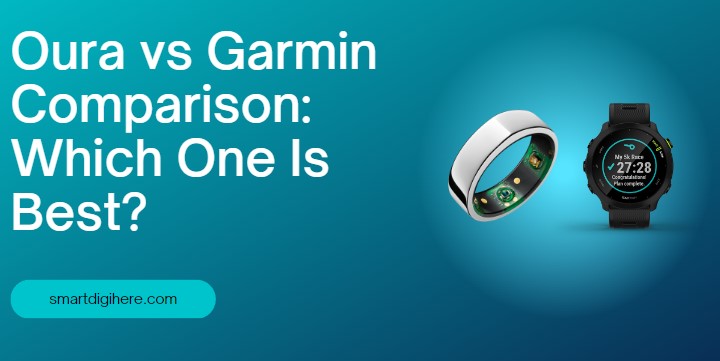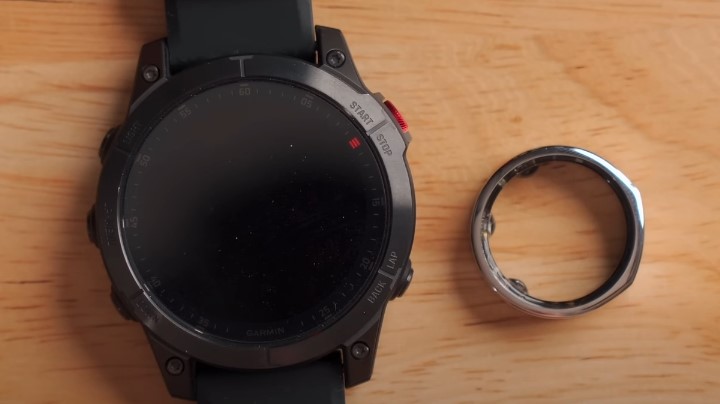In recent years, wearable technology has exploded in popularity, allowing consumers to monitor and track their fitness and health in real time. Two companies that have gained significant attention in this space are Oura and Garmin.
Oura, a Finnish company, is known for its Oura Ring, a small wearable device that tracks various health metrics, including sleep, activity, and heart rate variability. On the other hand, Garmin is an American multinational tech giant renowned for its connected wearables range equipped with GPS, fitness tracking, and health monitoring.
While both brands offer wearable devices targeted at activity and health tracking, each has strengths and weaknesses. This guide dives deeper into the key features of the Oura Ring and Garmin smartwatches, comparing (Oura vs Garmin ) and contrasting the two to help you decide which wearable device suits your needs the best.

Oura vs Garmin: General Design
In terms of design, Oura and Garmin have taken different approaches to their wearable devices.
The Oura Ring is a small, lightweight ring that sits on the finger, measuring just a few millimetres in thickness. It is available in several colours and premium finishes, including Silver, Black, Stealth, and Gold, allowing users to choose a style that fits their taste. The device is made of durable, high-quality titanium and has a sleek, jewellery-like design that blends seamlessly with everyday clothing.
One of the unique features of the Oura Ring is its lack of a screen, setting it apart from traditional smartwatches and fitness bands. It means the Ring is less distracting than a smartwatch, as it doesn’t constantly bombard the wearer with alerts and notifications. Instead, users can check their activity and sleep data by syncing the device with the Oura app on their smartphone.
In contrast, Garmin’s smartwatches, obviously designed to sit on the wrist, are bulkier than the Oura Ring but still sleek and stylish. They come in various shapes and sizes, from round to rectangular faces, with different colour and band options, including leather, silicone, and metal.
Most Garmin watches feature vibrant, high-resolution displays. Therefore, reading mobile notifications and accessing other features is straightforward, including music control, GPS tracking, making phone calls, and replying to texts. But all this can be more distracting and less suitable for individuals who want to limit their screen time and reduce distractions throughout the day.
Ultimately, both Oura and Garmin offer wearable devices that are aesthetically pleasing, with designs that cater to different preferences. The Oura Ring’s discreet form factor and minimal design may appeal to those who prefer a subtle wearable. Garmin’s smartwatches are better suited for others looking for a more traditional-looking watch with “smart” capabilities. You should also read our related article about the best Garmin connect iq apps.
Oura vs Garmin: Durability
Protection-wise, both Oura and Garmin offer wearable devices built to last and withstand daily wear and tear.
The Oura Ring is designed to be durable and is made of lightweight titanium, making it resistant to scratches and damage from everyday use.
And with a 10 ATM (atmospheres) water-resistance rating, the Ring can withstand water pressure up to 100 meters for an hour. It makes it suitable for showering, swimming, and other water-based activities.
Similarly, Garmin’s smartwatches use high-quality materials such as stainless steel and feature scratch-resistant lenses, which help to protect the device from everyday use.
Not all Garmin devices are “waterproof”, with some models water-resistant to a certain depth. For instance, Garmin’s high-end smartwatches, such as the Fenix 6 and Instinct, boast a water-resistant rating of 10 ATM, while other models, such as the Vivoactive 4 and Venu, are rated only for 5 ATM.
Overall, Oura and Garmin offer build-to-last wearables resistant to everyday abuse. However, being more compact and lightweight, Oura Ring is less likely to be accidentally bumped or scratched during daily wear.
Additionally, the Oura Ring’s higher water-resistant rating of 10 ATM makes it more suitable under high-pressure water activities, while some of Garmin’s devices may not.
Learn more: Is Whoop better than Garmin?
Regarding “Waterproofing”
Despite their water-resistance capabilities, both Oura and Garmin devices aren’t immune and may still be susceptible to damage under high-pressure water activities, such as scuba diving or snorkelling.
It’s vital to check the water resistance rating of both Oura and Garmin devices before wearing them to water bodies. We suggest following the manufacturer’s respective guidelines and avoiding exposing the devices to extreme water pressure or submerging them in water for extended periods to prevent damage.
Related: Can Oura rings go in water?
Oura vs Garmin: Activity Tracking

As for tracking day-to-day activities, both Oura and Garmin offer a range of features and sensors to help users monitor their physical activity and health.
The Oura Ring can track dozens of activities, including basic exercises like walking, running, strength training, and more unique activities like surfing and household work. It auto-detects and logs the activity type, duration, intensity, and time of day. The accuracy of the data may not be as precise as some of Garmin’s more advanced smartwatches and fitness trackers.
Garmin’s smartwatches and fitness bands are renowned for their advanced activity-tracking features. They have a range of motion sensors and GPS, with personalised coaching to help users track their progress and improve their fitness levels.
Garmin’s wearable lineup includes slimmer band designs like the Vivofit 4 and Vivosport 5 to more advanced smartwatches like the Venu 2 and Vivomove Sport, providing users with options to meet their specific needs and preferences.
Overall, Oura and Garmin have impressive fitness tracking capabilities that provide insights into daily and weekly activities and daily metrics such as calorie burn, step count, and average heart rate during workouts.
Oura vs Garmin: Health Monitoring
Both Oura and Garmin are known for their advanced health monitoring features. Oura’s marketing for its Ring somewhat centres around sleep monitoring, collecting in-depth data on users’ sleep stages (light, deep, REM), latency, timing, and quality.
The Oura companion app, combining all the sleep data with overnight biometric readings, prepares a readiness score for the day ahead. And with heart rate variability (HRV) tracking, one can monitor their stress levels and recovery.
Garmin wearables are diverse in health-tracking features, including sleep and stress tracking, HR monitoring, and menstrual cycle tracking. Other more advanced features include “Pulse Ox”, which measures blood oxygen saturation levels, and “Body Battery”, which uses activity, HRV, and stress levels to calculate users’ energy levels throughout the day into a legible score.
Conclusively, Garmin’s range of wearables offers a more comprehensive feature set than the Oura Ring in health monitoring. However, the latter is more specialised in sleep tracking, and its HRV tracking feature can provide valuable insights into stress and recovery. Plus, it’s less cumbersome to wear when sleeping than on-wrist wearables.
Read also: Which is better Apple Watch or Garmin Vivoactive 4?
Oura vs Garmin: Battery Life
Oura and Garmin wearables differ in terms of battery life. The Oura Ring (Gen 3) has a battery life of 4 to 7 days, depending on usage, before you must charge it using the included wireless charging dock. On the other hand, Garmin’s smartwatches have varying battery life depending on the model, with some lasting up to 20 days and others lasting up to 50 hours with GPS/LTE enabled.
Garmin’s smartwatches generally have longer battery life than the Oura Ring, but it vastly varies depending on usage and the specific model. They can be beneficial for users who want to use their devices for extended periods without worrying about recharging.
That said, the Oura Ring’s battery life, for its compact form factor, is still impressive, and the included wireless charging base station makes it easy to keep the device charged and ready to use.
Oura Ring Gen 3 Vs Garmin Battery Video Guide
Oura vs Garmin: User Experience
Garmin’s smartwatches use their own operating system, designed to provide an intuitive and customisable experience. The OS is well-designed and user-friendly, allowing users to take a quick peek at their health and fitness data, personalise watch faces and widgets, and access hundreds of first and third-party apps from the Connect IQ Store. Some models even have built-in storage for music and support contactless payments.
The Garmin Connect mobile app is similarly well-designed, with a straightforward interface that gives users a detailed look at their health and fitness data. The app offers a range of features you can play around with to personalise your experience, including customisable data fields and dashboards. It also includes social features where users can connect with friends and family and participate in challenges and leaderboards.
In contrast, the Oura Ring doesn’t have a screen and relies solely on the companion mobile app for data analysis and insights. This inability to view data directly on the device can be inconvenient for users who want quick and easy access to their health and fitness data.
Fortunately, Oura’s mobile app offers a clear and concise overview of users’ sleep and activity data in easy-to-understand scores. Furthermore, you get personalised guidance and suggestions based on user’s data and goals, helping them make informed decisions about their wellness.
The built-in software experience is what makes Garmin wearables suitable for standalone use. But if you don’t mind relying on your phone for data analysis and insights, Oura is still a good option.
Check out: Oura Ring vs. Fitbit: Which Is a More Accurate?
Oura vs Garmin: Which One’s For You?
In summary, both Oura and Garmin offer excellent options for those looking to track their fitness and health metrics.
The Oura Ring is a discreet and stylish wearable that excels at sleep tracking and offers water resistance up to 100 meters. However, its lack of a screen means that users must rely entirely on the app for data insights, and its activity tracking capabilities aren’t as advanced as those found on Garmin’s devices.
Garmin’s smartwatches and fitness bands offer a more comprehensive fitness and health monitoring suite, precise activity tracking, built-in GPS, Connect IQ apps, mobile payments, and music storage. And thanks to the built-in OS, users can leave their phones at home and still track their activity and stay connected. But some Garmin models can be bulky and less discreet than the Oura Ring.
Availability varies by model, but Oura and Garmin wearables are widely available online and through authorised retailers. Ultimately, the choice between the two depends on individual needs and preferences.